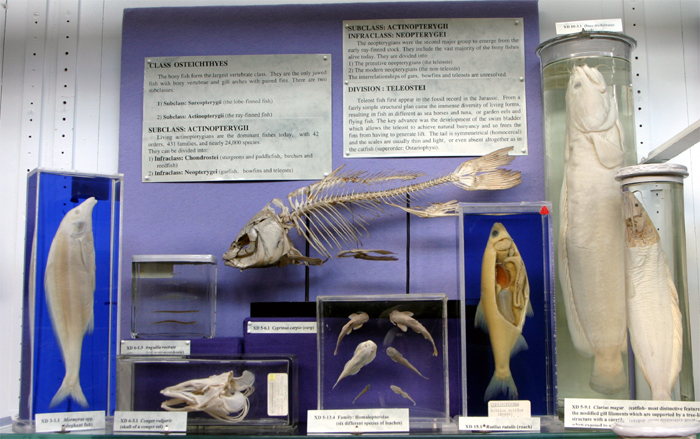
SUBCLASS ACTINOPTERYGII: MODERN TELEOSTS
By far the vast majority of species of modern fish are teleosts classified together in the division Teleostei within the infraclass Neopterygii. Teleost fish first appeared in the fossil record in the Jurassic. It has been suggested that the teleosts derived from a chondrostean lineage of fish such as Elonichthys. From a fairly simple structural plan, the main line of fish evolution developed into an immense diversity of forms, resulting in fish as different as eels and flying fish, sea horses and flatfish. The key advance was the swim bladder which allows teleosts to achieve weightlessness - neutral buoyancy - and so frees the fish from having to generate lift.

TELEOST SKELETON
The bony skeleton of a carp (above center) represents the teleost skeleton. The name tele-ostei (end-bone) refers to the specialised bones at the end of the vertebral column that support the symmetrical, homocercal caudal fin. Teleost skeletons typically comprise bony vertebrae and two pairs of ribs enclosing the viscera. There are pectoral, pelvic and anal fins. The fin rays are composed of bony segmented rays (lepidotrichia). The upper part of the cranium protects the brain. The orbit for the eyes is large and easily visible. The gills are covered by an operculum. A series of spines protrude above and below the vertebrae behind the ribs. The ctenoid bony scales are usually light and thin or even absent as in catfish.
EVOLUTION OF MODERN TELEOSTS AND THE DISPLAY
The modern view is that the species belonging to thirty six of the forty two teleost orders represent one main line of bony fish evolution and they are therefore classified together within the infradivision Euteleostei. There appear to be at least six major groups, classified as superorders, within this main line. The other six orders represent three specialised or relict offshoots of the main line, each of which is classified as an infradivision within the division Teleostei.
Our display contains a few species from each of the three specialised or relict offshoots of the main line and from each of the six superorders within the infradivision Euteleostei. The fish displayed here show how flexible the basic teleost plan has been.
SPECIALISED OR RELICT OFFSHOOTS OF MAIN TELEOST LINE
Infradivision Osteoglossomorpha – elephant fish.
Infradivision Elopomorpha – eels.
Infradivision Clupeomorpha - herring.
MAIN LINE OF EVOLUTION: EUTELEOSTS
Superorder Ostariophysi – carp, loaches, roach, catfish.
Superorder Protacanthopterygii – trout, powan.
Superorder Stenopterygii – bristlemouth, anglemouth, dragonfish, hatchetfish.
Superorder Scopelomorpha – spiderfish, lanternfish.
Superorder Paracanthopterygii – Atlantic cod, grenadier, anglerfish.
Superorder Acanthopterygii – flying fish, rock bass, angelfish, mudskipper, eelpout, seahorses, remora, weever fish, porcupine fish and cowfish, sunfish, flatfish.






